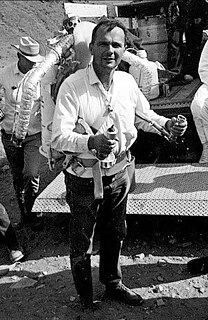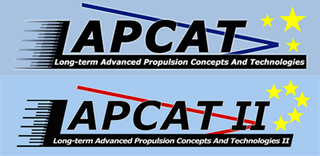
A rocket is a missile, spacecraft, aircraft or other vehicle that obtains thrust from a rocket engine. Rocket engine exhaust is formed entirely from propellant carried within the rocket before use. Rocket engines work by action and reaction and push rockets forward simply by expelling their exhaust in the opposite direction at high speed, and can therefore work in the vacuum of space.

A ramjet, sometimes referred to as a flying stovepipe or an athodyd, is a form of airbreathing jet engine that uses the engine's forward motion to compress incoming air without an axial compressor or a centrifugal compressor. Because ramjets cannot produce thrust at zero airspeed, they cannot move an aircraft from a standstill. A ramjet-powered vehicle, therefore, requires an assisted take-off like a rocket assist to accelerate it to a speed where it begins to produce thrust. Ramjets work most efficiently at supersonic speeds around Mach 3. This type of engine can operate up to speeds of Mach 6.
Monopropellants are propellants consisting of chemicals that release energy through exothermic chemical decomposition. The molecular bond energy of the monopropellant is released usually through use of a catalyst. This can be contrasted with bipropellants that release energy through the chemical reaction between an oxidizer and a fuel. While stable under defined storage conditions, monopropellants decompose very rapidly under certain other conditions to produce a large volume of energetic (hot) gases for the performance of mechanical work. Although solid deflagrants such as nitrocellulose, the most commonly used propellant in firearms, could be thought of as monopropellants, the term is usually reserved for liquids in engineering literature.

A scramjet is a variant of a ramjet airbreathing jet engine in which combustion takes place in supersonic airflow. As in ramjets, a scramjet relies on high vehicle speed to compress the incoming air forcefully before combustion, but whereas a ramjet decelerates the air to subsonic velocities before combustion, the airflow in a scramjet is supersonic throughout the entire engine. That allows the scramjet to operate efficiently at extremely high speeds.

A jet pack, rocket belt, or rocket pack is a device worn on the back which uses jets of gas or liquid to propel the wearer through the air. The concept has been present in science fiction for almost a century and became widespread in the 1960s. Real jet packs have been developed using a variety of mechanisms, but their uses are much more limited than their fictional counterparts because of the challenges of Earth's atmosphere, gravity, low energy density of available fuels, and the human body not being suited to fly, and they are principally used for stunts. A practical use for the jet pack has been in extra-vehicular activities for astronauts.

The Bell Rocket Belt is a low-power rocket propulsion device that allows an individual to safely travel or leap over small distances. It is a type of rocket pack.

Romanian Cosmonautics and Aeronautics Association, also known as ARCAspace, is an aerospace company based in Las Cruces, New Mexico, United States, that builds space rockets and other manned and unmanned aircraft intended for space exploration. It was founded in 1999 as a non-governmental organization in Romania by the Romanian engineer Dumitru Popescu and other rocket and aeronautics enthusiasts. Since then ARCA has launched two stratospheric rockets, four large scale stratospheric balloons including a cluster balloon and was awarded two governmental contracts with the Romanian government and one contract with the European Space Agency. ARCA Aerospace is currently developing a single stage to orbit rocket designed to be cost-effective rather than re-usable.

The de Havilland Spectre was a rocket engine built by the de Havilland Engine Company in the 1950s. It was one element of the intended mixed power-plant for combination rocket-jet interceptor aircraft of the Royal Air Force, such as the Saunders-Roe SR.177.

Vulcain is a family of European first stage rocket engines for Ariane 5 and the future Ariane 6. Its development began in 1988 and the first flight was completed in 1996. The updated version of the engine, Vulcain 2, was first successfully flown in 2005. Both members of the family use liquid oxygen/liquid hydrogen cryogenic fuel. The new version under development for Ariane 6 will be called Vulcain 2.1.

LAPCAT was a 36-month European FP6 study to examine ways to produce engines for a Mach number 4-8 hypersonic flight aircraft. The project ended in April 2008. It was funded by the European Commission research and development fund, and cost 7 million euros.

The Vickers Type 559 was a supersonic interceptor aircraft design by the British aircraft company Vickers-Armstrongs and was their submission for Operational Requirement F.155 in 1955.

The Bristol Siddeley BS.605 was a British take off assist rocket engine of the mid-1960s that used hydrogen peroxide and kerosene propellant.

The LE-5 liquid rocket engine and its derivative models were developed in Japan to meet the need for an upper stage propulsion system for the H-I and H-II series of launch vehicles. It is a bipropellant design, using LH2 and LOX. Primary design and production work was carried out by Mitsubishi Heavy Industries. In terms of liquid rockets, it is a fairly small engine, both in size and thrust output, being in the 89 kN (20,000 lbf) and the more recent models the 130 kN (30,000 lbf) thrust class. The motor is capable of multiple restarts, due to a spark ignition system as opposed to the single use pyrotechnic or hypergolic igniters commonly used on some contemporary engines. Though rated for up to 16 starts and 40+ minutes of firing time, on the H-II the engine is considered expendable, being used for one flight and jettisoned. It is sometimes started only once for a nine-minute burn, but in missions to GTO the engine is often fired a second time to inject the payload into the higher orbit after a temporary low Earth orbit has been established.

The Armstrong Siddeley, later Bristol SiddeleyGamma was a family of rocket engines used in British rocketry, including the Black Knight and Black Arrow launch vehicles. They burned kerosene fuel and hydrogen peroxide. Their construction was based on a common combustion chamber design, used either singly or in clusters of up to eight.

The Napier Scorpion family of rocket engines,, are a family of British liquid-fuelled rocket engines developed and manufactured by Napier at the Napier Flight Development Establishment, Luton, in the late 1950s.

The Armstrong Siddeley Stentor, latterly Bristol Siddeley BSSt.1 Stentor, was a two-chamber HTP rocket engine used to power the Blue Steel stand-off missile carried by Britain's V bomber force. One chamber was used for initial boost, then, 29 seconds after release the boost chamber was shut down and a smaller cruise chamber was used for most of the flight.
The Sprite, (DSpr.n) was a British rocket engine built by de Havilland for use in RATO applications. For RATO use only a short burn time is required, with simplicity and light weight as major virtues. The intended market was for assisting take-off of de Havilland Comet 1 airliners and also for V bombers carrying heavy nuclear weapons. 30 successful test flights were carried out by Comets, from May 1951, but gas turbine performance improved rapidly, and so RATO was not required in service.

Haas is a family of rocket space launchers developed by the ARCAspace for the Google Lunar X Prize competition and for their national manned space program. It consists of Haas balloon-launched orbital rocket, Haas 2 airplane-launched orbital rocket, Haas 2b ground-launched suborbital rocket and Super Haas ground-launched orbital rocket.
The R.A.E. Vickers Transonic Research Rocket was developed from the Miles M.52 a British research supersonic aircraft a project which was undertaken in top secrecy between 1942 and 1945 to a Ministry of Supply specification E.24/43. The project was cancelled because the Government of the day was persuaded that with the accumulation of data it was felt that the E.24/43 aircraft was unlikely to reach sonic speed. Wind tunnel model tests apparently indicated serious loss of longitudinal stability at high subsonic speed as was then characteristic of existing aircraft. The decision was reached to acquire preliminary experience of flight under transonic conditions using rocket-driven pilotless scale models. The Ministry of Supply (MOS) formed the Guided Projectile Establishment under W. P. Cooke at Westcott, Buckinghamshire, and the Rocket Propulsion Group under A. D. Baxter at RAE, Farnborough. Work commenced in applying German technology, with the Halstead Experimental Centre of the MOS monitoring commercial exploitation.

















